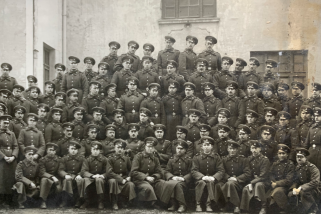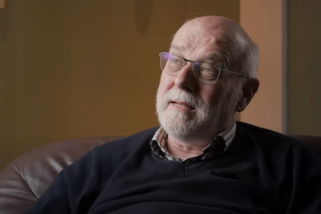The International Echoes of the Commemorations of the October Revolution (1918-1990)
Deadline: 30 november 2015
Switzerland, University of Lausanne, Géopolis (Room: 2227) Date: 14-16 September 2016
Organising Committee: J-F Fayet (Univ. of Lausanne) – Stéfanie Prezioso (Univ. of Lausanne) – Kevin Morgan (Univ. of Manchester) – Norman Laporte (Univ. of South Wales) Scientific Committee: Dr. Marco Albeltaro (Univ. of Torino, Historia Magistrae. Rivista di storia critica), Prof. Korine Amacher (Univ. of Geneva), Dr. Bernhard Bayerlein (Ruhr-Univ. Bochum, dir. The International Newsletter of Communist Studies), Prof. Sophie Coeuré (Univ. Paris-Diderot), Prof. Angelo d’Orsi (Univ. of Torino, Historia Magistrae. Rivista di storia critica), Prof. Sabine Dullin (IEP Paris), Prof. Jose Maria Faraldo Farillo (Complutense Univ. of Madrid), Prof. José Gotovitch (Univ. Libre of Brussels), Prof. Gianni Haver (Univ. of Lausanne), Prof. Catherine Gousseff (dir. of Marc Bloch Center, Berlin), Dr. Alexander Hobel (Fondazione Istituto Gramsci), Dr. William A. Pelz (dir. Institute of Working Class History, Chicago), Prof. Silvio Pons (Univ. of Roma II, dir. of Gramsci Foundation), Dr. Tauno Saarela (Univ. of Helsinki), Prof. Emer. William H. Sewell Jr. (Univ. of Chicago), Prof. Brigitte Studer (Univ. of Bern), Prof. Emer. Ronald G. Suny (Univ. of Chicago), Prof. Alexandre Vatlin (Lomonosov Moscow State Univ.), Prof. Jean Vigreux (Univ. of Bourgogne, dir. ANR Paprik@2F).
Sponsors: Swiss National Science Foundation, University of Lausanne, Manchester University, the journal Twentieth Century Communism: a Journal of International History.
Publication of the Lausanne international conference proceedings in a special volume of the journal Twentieth Century Communism: a Journal of International History.
Publication Date: during 2017 (deadline for submitting papers November 2016). Additional publication could be considered depending on the number and quality of the papers presented.
Call for Papers :
The International Echoes of the Commemorations of the October Revolution (1918-1990)
It is necessary (for purely political reasons) to demonstrate to the diplomats and to members of the Communist International the strength of the Republic and the faith the masses of workers have in Soviet power
Telegram from Trotsky to the CC of the PCR, 1920 F.17/60/163, RGASPI
My only consolation is that as celebrations are bourgeois institutions at which nobody tells the truth it perhaps just as well that I shall be at a safe distance
Letter from G. B. Shaw (who could not attend) to Polovtseva, 18.10.1927, F.5283/8/47, GARF Synopsis:
Commemorations express a political will to remember, a process that relies on establishing a mythologised historical referent. The Russian Communists were aware of the importance of this instrument for the implantation of a regime whose legitimacy was contested both domestically and abroad, and proceeded therefore to construct a new collective memory through the reordering of time around the regime’s founding act: the great socialist revolution of October. From 1918 on, 7 November was a day of celebrations: speeches, military parades, orderly marches, inaugurations of public monuments commemorative plaques, political carnivals, mass spectacles, and popular parties that united the peoples and territories of the Soviet Union in celebration of October. In addition to their domestic role in fostering unity, providing legitimacy, and facilitating internal mobilisations, the practices of commemorations also supported the regime’s international eminence, especially when it presented itself as a model for world revolution.
Inviting foreign dignitaries to celebrations of sovereignty is a tradition as old as diplomacy itself. However, assisted by their numerous political (the communist parties), trade-unionist, and above all associative conduits, in terms of both quantity (the number of persons invited) and quality (the methods of selecting candidates and their handling during the visit), the Soviets took this tradition to a whole new level. While in the first few years celebrations were a modest affair, a thousand foreign delegates are invited to the Soviet Union for the tenth anniversary of the revolution, celebrated in 1927. Unlike the ambassadors, these representatives of the international working class and progressive social forces are far from being passive spectators. Their status, however, is ambiguous. Invited as observers, they are expected to take sides, and then to commit themselves. They have a role in the October spectacle and its political usages. The Soviets intend to show the world that the USSR is not isolated, and that its international legitimacy extends beyond the limited gamut of its diplomatic relations. During this period, except for the duration of the “Great Patriotic War”, foreigners attend the celebrations every year, although at greatly varying numbers. After 1945, it becomes standard to invite the ambassadors posted to Moscow, the heads of friendly states (from Europe, Asia, and soon from Latin America), and the leaders of Communist parties. The circle of invitees traces the contours of, and the fluctuations in, Soviet foreign policy. Let us also highlight the return of youth and women delegations, as well as the presence of intellectuals. In the 1960s, the Red Square becomes an almost obligatory passageway for the representatives of the “progressive” movements of the Third World (the Vietnamese are the most regular, but one finds also Ethiopians, Somalians, and others). In 1977, the sixtieth anniversary parade is watched from the tribunes by over a hundred foreign delegations from left-wing formations, joined by the head of states of communist countries and by the president of Finland (T. Kekkonen). The number of attendees remains high for the seventieth anniversary a decade later and until the last commemoration, in 1990.
Commemorative events were also held outside the Soviet Union, constituting another aspect of the international reach of the October Revolution. Initially, they were small events, organised spontaneously—in Zurich in 1918, Turin 1919, Beijing 1923, but also in Prague, London, Paris, etc.— small street processions, lectures, discussions in factories, an evening at a community centre, evidence of the hopes the Revolution inspired beyond its borders. But in 1927, gigantic meetings take place in Berlin, Paris, London, New York, with workers’ banquets and the projection of Soviet films. An exhibition with fifteen pictures travels across Europe and the Americas under the title “ten years of socialist edification”. In many countries, workers organize strikes in solidarity with the Soviet working class. The internationalisation of the celebrations becomes progressively enmeshed in a very structured context that includes Soviet institutions (embassies, commercial services, and cultural missions), the Communist International, and the many mass organisation that orbit the Communist Parties—in the manner of, for example, the Friends of the Soviet Union. A similar development takes place in Russia: the chaotic, political and artistic carnival of the early commemorations is transformed with time into a very conventional, repetitive, and scripted display of militarism and patriotism. The commemorative date is fixed, but it is part of a changing commemorative calendar. At the beginning, 1 May remains the other great ‘proletarian commemoration day’. A focus on leaders and martyrs – the ‘3 Ls’ of Lenin, Luxemburg and Liebknecht – then shifts under Stalin to the leader’s birthday and a form of commemorative competition.
The military victories of the Soviet Union in the “Great Patriotic War” will lead to the further key commemoration day of 9 May. There is also the exportation of the soviet culture of commemoration, initially to the newly “liberated” areas, with celebrations of 7 November taking place across a Russia that extends from Kaliningrad to Sakhalin, as well as in the Baltic countries and in Moldavia. Next it is the turn of the people’s democracies to integrate the date of the October Revolution in their official calendar, and also to reproduce the Soviet commemorative model in the scope of their own national days, albeit with efforts to mark it with certain national variations. In the capitalist countries, the small communist organisations take advantage of the new prestige of the USSR, victor of the Great War, in order to hold modest commemorative events: concerts, theatre shows, lectures series, etc.
Finally, the spectacle of the celebrations is broadcast around the world, first by radio and news reels, and later by television. This was evidently the case with countries in the Soviet orbit. Like in many other people’s democracies, the television services of East Germany and Hungary broadcasted the ritual processions. But this mediated commemoration reached also into Western democracies. Every year in the US, regularly in France and Italy, less often in Switzerland, the October parades were rebroadcast on the national channels. The broadcasting of the military procession was incorporated into the setting of the Cold War, providing fodder for Western military experts and Kremlinologists. While the latter offered theories about the balance of power at the top of the hierarchy deduced from the seating arrangements on the Mausoleum’s balcony, the viewer could see the aging of the leaders, a metaphor for the regime itself, and the growing standardisation of the festivities, symbol of its advancing bureaucratisation. Everywhere, the commemorations represented a pertinent index of the political culture of the country that produces them.
Keywords for proposals (two primary axes):
The Participations of foreigners in the 7 November commemorations in the USSR
Foreigners invited to the USSR for the October celebrations
Workers delegations, by country, political and occupational categories, function,
organizational type (sports, Esperanto-related, pacifist, women, youth, etc.)
Intellectuals, scientists, and progressive artists
Leaders of allied states: the Mongol Republic, European people’s democracies,
North Korea, China, Cuba, African states, etc.
Military attachés, diplomats, government officers
Journalists
Undercover
Absentees (those who could not come, those who rejected the invitation)
Personal consequences of the visit: joining the party, promotion/exclusion in the
trade union, job loss, etc.
The Soviet side: the inviting structure and the handling in situ
Organising committees
Welcome desk for the foreigners of the VOKS
The foreign relations committee of the trade unions
Communist International, Sportintern, KIM…
Culture Ministry
NKID-MID…
Translator-guides
Intourist
The political police (INO-Tcheka)
Activities – key moments – mandatory stations for the foreigners
The warm welcome: cheering crowds everywhere
The learning trip: the itineraries in the different republics
The organised tours:
Questions time: “tell us the truth comrades…”
The commemorative vigils: the stories of veterans, the shows put by worker clubs
The military parade, the marching columns and the popular holiday of 7
November
Activities upon return: written and oral testimonies
Celebrations of 7 November abroad: by country, type of place, and type of event
I. Commemorations in different territories
The big cities: Berlin in 1927, London, Paris, Rome, in the US, Beijing (from 1923
at the university)
Allied states: people’s democracies in Europe; in Asia: China, North Korea,
Vietnam; in Latin America: Cuba…
Africa:Ethiopia
Commemorations in Soviet spaces outside the USSR
Embassies
Cultural centres
Friend circles (Friends of the USSR)
The Communists Parties
Factories
Delegations and tours abroad: political, artists…
Official Soviet delegations
Lecture tours
Cultural events : exhibitions, concerts, and commemorative shows
Opposition events
a. Take over or boycott of events, dissidentevents
Anti-Soviet events
Competing events (Mensheviks, Trotskyist, etc.)
The commemorations in foreign medias
The foreign press
The foreign radio
The newsreels
The foreign television broadcasts
Films of October as international commemorative medium
October in the communist calendar
Proletarian commemoration days
Heroes and martyrs as a focus for commemoration
Commemorative competition: 1 May, 9 May and the leader’s birthday
Paper Proposals
We invite submissions of proposals for papers on issues pertaining to the international echoes of the commemorations of the October revolution.
Priority will be given to proposals that emphasise long timeframes, use a comparative approach, involve the prosopography of attending delegates, or deal with the international circulation of commemorative practices.
Proposals should include the title of the presentation, an abstract, and a description of the sources. Length should be about 2500 signs. Proposal should be sent to: october17commemoration@unil.ch by 30 November 2015, together with a brief CV including the most important (maximum five) publications.
Financial Matters
In case of a proposal’s acceptation, the costs of the stay and the hotel will be covered. We kindly ask to use own funds for the travel costs. Only in case this should not be possible, coverage of the travel costs can be held in prospect.












